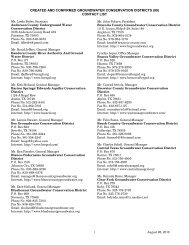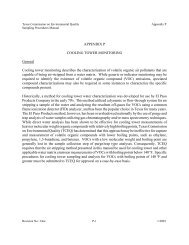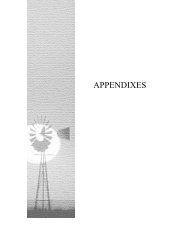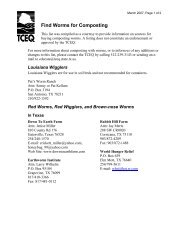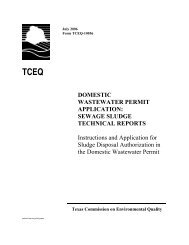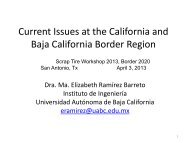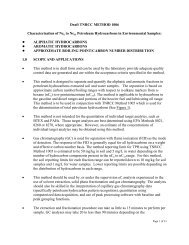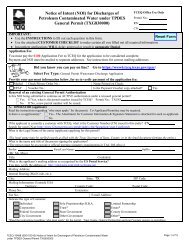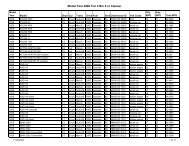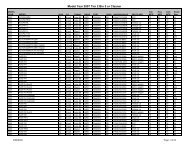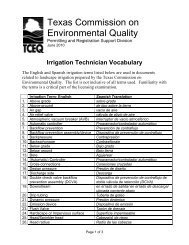joint groundwater report - Texas Commission on Environmental ...
joint groundwater report - Texas Commission on Environmental ...
joint groundwater report - Texas Commission on Environmental ...
You also want an ePaper? Increase the reach of your titles
YUMPU automatically turns print PDFs into web optimized ePapers that Google loves.
due to completed acti<strong>on</strong> from this and previous <str<strong>on</strong>g>report</str<strong>on</strong>g>s. For 1997, 6,338 cases are listed by county in Table 1under the divisi<strong>on</strong> heading "PST.” Of these, there are 6 cases which required notificati<strong>on</strong> to local officialsunder §5.236 of the <str<strong>on</strong>g>Texas</str<strong>on</strong>g> Water Code since the previous <str<strong>on</strong>g>report</str<strong>on</strong>g>’s publicati<strong>on</strong>. There were 1,308 new casesof <str<strong>on</strong>g>groundwater</str<strong>on</strong>g> c<strong>on</strong>taminati<strong>on</strong> identified and added in 1997. A total of 477 cases were deleted from the 1996<str<strong>on</strong>g>report</str<strong>on</strong>g> of which acti<strong>on</strong> was completed (activity status 6) <strong>on</strong> 448 cases. The great majority of the cases involve<str<strong>on</strong>g>groundwater</str<strong>on</strong>g> with documented c<strong>on</strong>taminati<strong>on</strong> problems. A small percentage are cases where <str<strong>on</strong>g>groundwater</str<strong>on</strong>g> isimminently threatened.Polluti<strong>on</strong> Cleanup Divisi<strong>on</strong>Federal and State Superfund Program Descripti<strong>on</strong>. In 1980 the United States C<strong>on</strong>gress passed theComprehensive Envir<strong>on</strong>mental Resp<strong>on</strong>se, Compensati<strong>on</strong>, and Liability Act (CERCLA), comm<strong>on</strong>ly known asthe "Superfund" law. The purpose of the federal Superfund legislati<strong>on</strong> was to protect public health and theenvir<strong>on</strong>ment from hazardous substances by authorizing federal acti<strong>on</strong> in resp<strong>on</strong>se to releases into theenvir<strong>on</strong>ment from aband<strong>on</strong>ed hazardous waste sites. Potentially c<strong>on</strong>taminated sites referred to the Polluti<strong>on</strong>Cleanup Divisi<strong>on</strong> (PCD) by the TNRCC’s district offices, the EPA, local government entities, and individualsare evaluated and ranked according to the degree of hazard presented to the public health and theenvir<strong>on</strong>ment. High ranking sites are referred to the EPA for placement <strong>on</strong> the Nati<strong>on</strong>al Priorities List (NPL).When sites are listed <strong>on</strong> the NPL, TNRCC staff petiti<strong>on</strong>s EPA for federal funds for planning, siteinvestigati<strong>on</strong>, feasibility studies, design work, remediati<strong>on</strong>, and operati<strong>on</strong> and maintenance of the site.The <str<strong>on</strong>g>Texas</str<strong>on</strong>g> State Superfund Program was created in 1985 by amendment to the <str<strong>on</strong>g>Texas</str<strong>on</strong>g> Solid Waste DisposalAct to address those sites not eligible for funding under the Federal Superfund Program. The State SuperfundProgram follows the same step-by-step process, from corrective acti<strong>on</strong> planning to remediati<strong>on</strong>, as describedfor the federal program. The Act requires that sites placed <strong>on</strong> the State Superfund Registry first seek fundingfor site cleanup from resp<strong>on</strong>sible parties, then federal resources, and lastly state resources.Groundwater m<strong>on</strong>itoring activities occur throughout the Superfund process, from planning throughremediati<strong>on</strong>. Residential and industrial wells near a potential site, in additi<strong>on</strong> to existing or newly installedsite m<strong>on</strong>itoring wells, would typically be sampled to help determine whether a site warrants placement <strong>on</strong> theNPL. If not, the site would be evaluated for possible inclusi<strong>on</strong> <strong>on</strong> the <str<strong>on</strong>g>Texas</str<strong>on</strong>g> State Registry of HazardousWaste Sites for remediati<strong>on</strong> under the State Superfund Program. Once placed <strong>on</strong> either the NPL or stateregistry, the potentially resp<strong>on</strong>sible parties (PRPs) are provided the opportunity to enter into an enforceableorder to c<strong>on</strong>duct all aspects of site investigati<strong>on</strong> and remediati<strong>on</strong>. If the PRPs are unwilling to enter into anenforceable order, the state proceeds with this work.A site investigati<strong>on</strong> is c<strong>on</strong>ducted to characterize the type and volume of c<strong>on</strong>taminants at a site, the media(such as soil or <str<strong>on</strong>g>groundwater</str<strong>on</strong>g>) c<strong>on</strong>taminated, the lateral and vertical extent of c<strong>on</strong>taminati<strong>on</strong>, the risk the siteposes to human health and the envir<strong>on</strong>ment, and to allow the selecti<strong>on</strong> of a remediati<strong>on</strong> technology during thefeasibility study. Groundwater m<strong>on</strong>itoring wells are installed during the site investigati<strong>on</strong> to determine theeffect, if any, a site has had or may have <strong>on</strong> local <str<strong>on</strong>g>groundwater</str<strong>on</strong>g> resources, and to select alternatives whichcould be used to solve the problems at the site. The remediati<strong>on</strong> technology selected is highly site-specific butmay involve acti<strong>on</strong>s to c<strong>on</strong>trol the source of the c<strong>on</strong>taminati<strong>on</strong> and/or to remove c<strong>on</strong>taminants from a<str<strong>on</strong>g>groundwater</str<strong>on</strong>g> bearing z<strong>on</strong>e. If the remedy involves the pumping and treatment of c<strong>on</strong>taminated <str<strong>on</strong>g>groundwater</str<strong>on</strong>g>,additi<strong>on</strong>al m<strong>on</strong>itoring wells are generally installed and hydrogeologic data collected during the remediati<strong>on</strong>. Inadditi<strong>on</strong>, after the remediati<strong>on</strong> is complete, <str<strong>on</strong>g>groundwater</str<strong>on</strong>g> m<strong>on</strong>itoring may occur as a part of the operati<strong>on</strong> andmaintenance phase for up to 30 years.43



